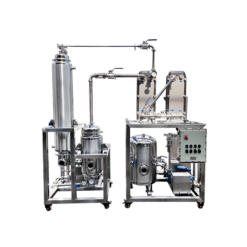Precautions for Using a Falling Film Evaporator
- Firstly, remove the gas in the equipment to create a vacuum environment. After the vacuum degree is enough, feed water in replacing materials. When water is running smoothly (water in the evaporator goes in and out, and the liquid level in the evaporation chamber can not exceed the sight glass), open circulating pump so that cooling water can be piped in, start the heating tube and start the discharge pump. After the equipment runs well, adjust throttling components in each position according to the the random process flow chart of the equipment. Then replace the material with water for running. When the vacuum degree and temperature difference meet the requirements, replace the material with water for running for more than 4 hours. It is qualified if the evaporation capacity meets the requirements. Otherwise, adjust the throttle element again.
- Start the vacuum pump. If it is a water ring vacuum pump, the water ring vacuum pump should be started at no load. After the water ring vacuum pump is running normally, the working water valve of the water ring pump is opened. When the vacuum and temperature difference of each effect reach the required level, water should be used instead of the material to start the operation and start the condensate. After the water is cut off, the material is put into the material tank. Open the sampling valve and discharge the water. Place the material that does not meet the concentration requirement into the tank. When the discharge concentration requirement is reached, open the discharge valve, close the sampling valve on the material tank, and put the equipment into normal operation.
- During the operation of the pump and before starting, make sure that the cooling water of the mechanical seal of the pump must not be interrupted, so as not to damage the mechanical seal of the pump.
- When the work is to be stopped, water is used instead of the material in the equipment and its pipeline to prevent the material from crystallizing or solidifying in the equipment. When the ambient temperature of the equipment is below 0 °C, the water in the equipment and its pipeline should be drained to avoid freezing or blocking the pipeline.
- When the machine pauses due to accidents such as sudden power failure, users should immediately close the valve, release the materials stored in the equipment and its pipeline as soon as possible, or dilute the heated water until it does not crystallize or solidify. When there is material in the equipment and its pipeline, the material pump should be started firstly to make the material run smoothly and then start the vacuum pump.
- During the operation, if the degree of vacuum is low, especially after restarting after accidental parking caused by power failure and so on, immediately find out if there is leakage at the flange and the joint, and block the leak in time.
- The cleaning of equipment: after the equipment is finished, the equipment and its pipelines should be washed and cleaned with water, 1-2% NaOH aqueous solution, clean water, 1-2% HNO3 aqueous solution and clean water. The pump should be pumped with the above washing liquid, and each washing time should not be less than 10 minutes.
- The equipment should not be washed by using hydrochloric acid or hydrochloric acid chloride-containing aqueous solution during scouring or cleaning to avoid intergranular corrosion of stainless steel equipment and affect the service life of the equipment.
Maintain a Falling Film Evaporator Regularly
- Always check whether the oil cup of the pump is short of oil, and whether the cooling water in the mechanical seal is broken.
- Always check the flanges and joints of the equipment for air leakage.
- When the mechanical seal of the pump is damaged, it should be replaced in time.
- When the check valve rubber ball and rubber gasket are damaged, they should be replaced in time.
- If the indications such as thermometer, vacuum gauge, pressure gauge and so on are inaccurate, they should be proofread or replaced in time.
- The surface of the equipment should not be rubbed with a hard scrubbing tool (such as steel brush) to avoid scratches and scratches on the stainless steel surface.
How to Use a Falling Film Evaporator Properly?
A falling film evaporator can continuously work under vacuum and low temperature conditions, with high evaporation capacity, energy saving and consumption reduction, low operating cost.
Falling Film Evaporators’ Troubleshooting
The falling film evaporators are greatly well-received in many industries as a high efficient evaporation and concentration equipment. However, when the falling film evaporators are
What is a Falling Film Evaporator?
A falling film evaporator is one of the most effective evaporators and well-received in many industries. So what is a falling film evaporator exactly? The
Falling Film Evaporator VS. Rotary Evaporator
Introduction to Falling Film Evaporators Falling film evaporators are efficient evaporation equipment widely used for the evaporation and concentration of evaporative material, water, organic solvents
How does a Falling Film Evaporator Work?
In the industrial field, there are always some substances which need to be extracted or concentrated. Therefore, there are also so many devices or techniques
Falling Film Evaporators’ Advantages and Disadvantages
A falling film evaporator refers to a concentration and evaporation device used in industries. It is applicable for the concentration and evaporation of water, organic
